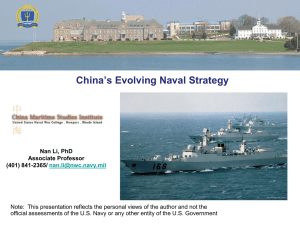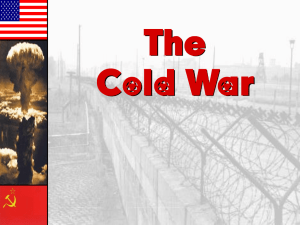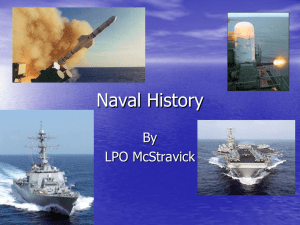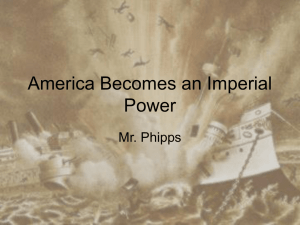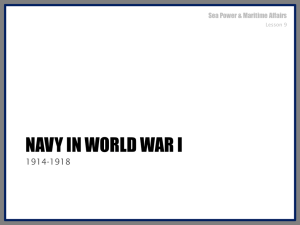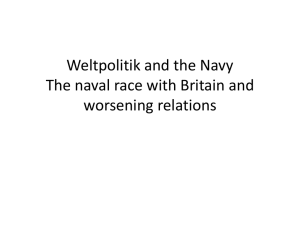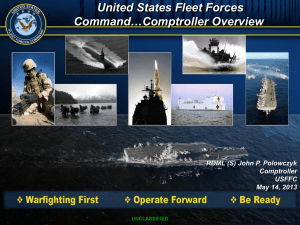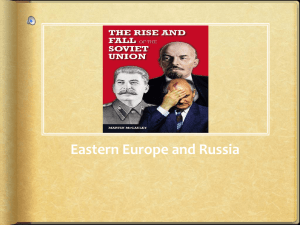Lesson-14-The-US-Navy-in-the-Strategy-of-Containment-1953
advertisement
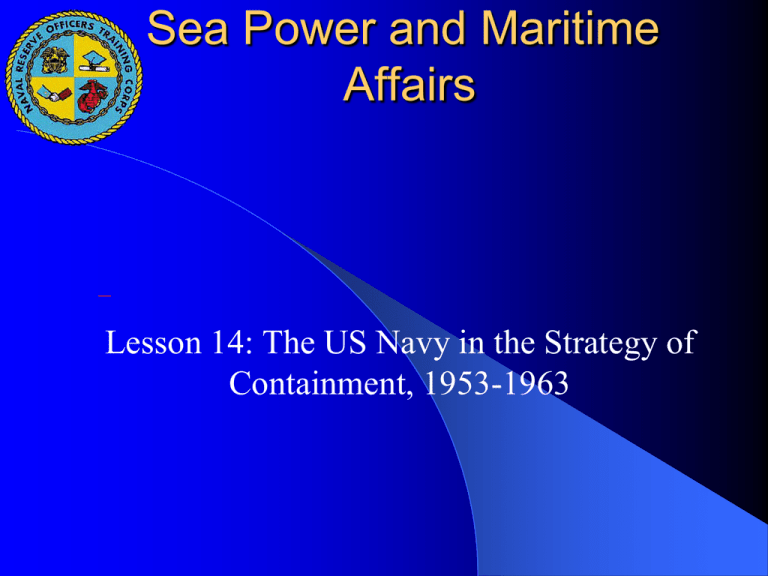
Sea Power and Maritime Affairs Lesson 14: The US Navy in the Strategy of Containment, 1953-1963 Learning Objectives Comprehend the development of new strategies and weapons systems, in terms of competition for resources within the DOD and within the Navy, during in the height of the Cold War. “Massive Retaliation,” “Rollback,” and “Liberation” will be defined and their applicability as strategic slogans will be assessed by examination of major crises of the Eisenhower Presidency. Comprehend how the threat of limited naval presence was used to influence international affairs during the 1950s. Learning Objectives President Kennedy's “Flexible response” will be defined and its applicability as a strategic slogan will be assessed by examination of the Bay of Pigs and the Cuban Missile Crisis. Know the impact of the Cuban Missile Crisis of 1962 on US naval strategy and national policy. NSC 68: Blueprint for Cold War Strategy National Security Council Report - April 1950 – Based on the Truman Doctrine, Marshall Plan, and George Kennan’s “Containment Strategy”. Threat from Soviet Union: – Leads the global advance of international communism. Korean War - National Security Council believes the perception of the communist threat is confirmed. NSC 68 NSC 68: “We must, by means of a rapid and sustained build-up of the political, economic, and military strength of the free world, and by means of an affirmative program intended to wrest the initiative from the Soviet Union, confront it with convincing evidence of the determination and ability of the free world to frustrate the Kremlin design of a world dominated by its will.” Naval decline reversed. – Accelerated shipbuilding. – Personnel strength doubled. Korean War Navy Reactivation of mothballed World War II ships. Development begins on a new generation of ships: – Forrestal-class carriers with jet aircraft. – Nuclear-powered submarines: USS Nautilus. Power-projection capabilities of the U.S. Navy. – – – – Close Air Support Interdiction Amphibious Operations Logistics Strategic bombing/massive retaliation theory disproved. USS Nautilus (SSN 571) Commissioned September 1954. First nuclear-powered submarine. First submarine to cruise under the North Pole. President Dwight D. Eisenhower Elected 1952 Administration increases military funding after the Korean War. Struggle for Funding Air Force’s Strategic Air Command (SAC) - 1946 – Controls U.S. strategic deterrence mission. Navy funding determines nature and mission of forces. Naval nuclear capability and strategic mission developed. – Ensures future funding for naval forces. – Internal Navy competition for funding. Elimination of new weapons except carriers and submarines. – Small carrier-based nuclear weapons. New tactical nuclear mission in addition to strategic mission. Single Integrated Operations Plan (SIOP) - 1960. – Attack plans for strategic bombers, ICBMs, and SSBNs. – Carriers lose strategic role - maintain tactical nuclear weapon. Regulus Missile - Program cancelled by 1964. Forrestal-class Attack Carrier (CVA) USS Forrestal (CVA 59) Ballistic Missile Submarines (SSBNs) USS George Washington (SSBN-598) Anti-Submarine Warfare (ASW) Soviet submarine threatens U.S. and NATO sea lines of communication. Hunter Killer Groups (HUKs) established. – One older fixed-wing support carrier (CVS) with aircraft. – Five to six destroyers (DDs) U.S. nuclear-powered attack submarines (SSNs). – Most effective ASW weapons eventually replace HUKs. – “Albacore” hulls and improved sonar and torpedoes. Long-range land-based maritime patrol aircraft. Underwater Sound Surveillance System (SOSUS). – Passive sonar located at strategic chokepoints. GIUK Gap - main chokepoint for Soviet submarines. U.S. Naval Presence in the Cold War Worldwide U.S. interests. – Strategy of containment must be backed by threat of force. – Naval deployments - worldwide. Influence international affairs. Threat of either limited or unlimited naval force. Numbered fleets deployed in different regions. – – – – – Second Fleet Third Fleet Sixth Fleet Seventh Fleet Fifth Fleet Atlantic Eastern Pacific Mediterranean Western Pacific and Indian Ocean Arabian Gulf (1995) Forward Deployed Forces Navy Containment Strategy – Naples (Gaeta), Italy Commander, Sixth Fleet – Yokosuka, Japan Commander, Seventh Fleet – Subic Bay, Philippines Marine Corps – Okinawa Third Marine Division Army and Air Force – Permanent bases established overseas. Germany, Japan, and South Korea. Admiral Arleigh Burke Chief of Naval Operations 1955-1961 Admiral Hyman G. Rickover Father of the Nuclear Navy and Naval Reactors USS Nautilus (SSN 571) USS Enterprise (CVAN 65) USS Long Beach (CGN 9) Former French colony. Indochina – Japanese occupation - WW II. 1945: Ho Chi Minh founds Democratic Republic of Vietnam. – Communist government. – Reoccupied by French forces. 1947: Vietnamese war for independence begins. – Vietnamese rural population supports Vietminh communists while French control cities. France appeals to U.S. for support. – Truman approves military aid to French forces. 1954: Dien Bien Phu - French surrender to Vietminh. – Eisenhower refuses to aid French with carrier strikes. – Operation “Passage to Freedom” – SEATO established Vietnam divided between communist North and South. – U.S. military advisors to South Vietnam. Suez Crisis 1956: Egyptian President Nasser nationalizes Suez Canal. Britain and France – Attacks on Egypt with Israel to regain control of canal. Soviet Union - aligned with Egypt. – Hungarian uprising. – Naval inferiority to U.S. fleet. U.S. diplomatic pressure on Britain, France, and Israel. – U.S. controls sea lines of communication in Mediterranean. – U.N. cease-fire brokered. – Soviets begin to increase power in Middle East. Eisenhower Doctrine - 1957 – U.S. will defend Middle East from Communist aggression. Lebanon Crisis 1957: Soviets launch “Sputnik” shaking U.S. confidence 1958: Lebanese Civil War Communists supported by Syria. Ally of Soviet Union. Amphibious Landing of 6,000 Marines. – Control of Beirut secured. Army and Air Force units unable to react. – Demonstrated flexibility of U.S. naval forces. Sixth Fleet dominates the Mediterranean. – Soviet Navy unable to influence events. The George Washington, launched June 9, 1959, was the Navy's 1st submarine in Nov. 1960 to deploy the solid-fuel Polaris missile with one-megaton warhead Polaris SubmarineLaunched Ballistic Missiles (SLBMs) Strategic Deterrence Nuclear Triad – With strategic bombers and ICBMs. Eventually replaced by Poseidon and Trident missiles on newer submarines. First Nuclear powered carrier commissioned (CVAN 65) Enterprise John Fitzgerald Kennedy Elected President over Eisenhower’s Vice President Richard Nixon in 1960. Navy PT boat commander in WW II as a Lieutenant. Nikita Khrushchev Succeeded Stalin as Soviet premier after his death in 1953. Proposed “peaceful competition” between the superpowers. – Challenged U.S. to meet Communist challenges in third world countries. The Cold War Heats The “Space Race”: Up – Sputnik: First man-made satellite - 1957. – Yuri Gagarin - First man in space - 1961. – Kennedy - Apollo Program will land a man on the moon “before the decade is out.” Naval aviators chosen among first astronauts. The “Missile Gap” debate in 1960 U.S. Presidential election. U-2 Incident - 1960 – Francis Gary Powers shot down over Soviet Union. Khrushchev's “We will bury you!” speech at the United Nations - 1960. Berlin Wall - 1961: – Kennedy: “Ich bin ein Berliner.” - 1963. U-2 Fidel Castro Leader of Cuban Revolution against U.S.supported President Batista in 1959. Establishes Communist government aligned with the Soviet Union. Castro and Khrushchev Cuban Missile Crisis Cuban Missile Crisis October 1962 Cuban Missile Crisis 1961 - “Bay of Pigs” Invasion: – CIA-trained Cuban rebels landed by U.S. Navy. – Defeated by Castro’s communists. 1962: Soviet nuclear missiles move to Cuba. – Located by Air Force U-2 reconnaissance plane. Options for President Kennedy: – Air strikes or invasion too risky - may start war. – Blockade or “Quarantine” of missiles established by Navy. 22 Oct 62- fleet directed to block military shipments from Cuba. 24 Oct 62- Soviet Ships reverse course, only one boarded – Khrushchev agrees to remove missiles. Cuban Missile Crisis “Conventional engagement”—involving small ships No attack carriers directly involved, but global U.S. alert including carriers world-wide Soviet had no symmetrical, opposing forces No fleet action; no hostilities Khrushchev and Kennedy played crucial roles! Soviet naval policy reviewed. – Need a more balanced Navy of surface, subsurface, and air forces to challenge U.S. for command of the seas. Discussion Next time: The US Navy, Vietnam and Limited War, 1964-1975


